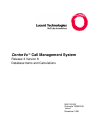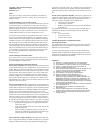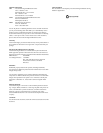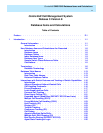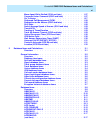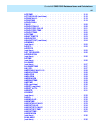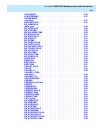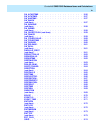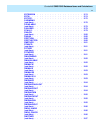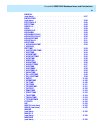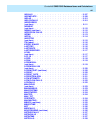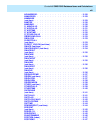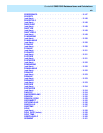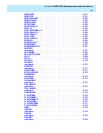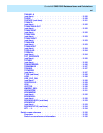Copyright
1999, Lucent Technologies
All Rights Reserved
Printed in U.S.A.
Notice
Every effort was made to ensure that the information in this book was
complete and accurate at the time of printing. However, information is
subject to change.
Your Responsibility for Your System’s Security
Toll fraud is the unauthorized use of your telecommunications system by
an unauthorized party, for example, persons other than your company’s
employees, agents, subcontractors, or persons working on your company’s
behalf. Note that there may be a risk of toll fraud associated with your
telecommunications system and, if toll fraud occurs, it can result in sub-
stantial additional charges for your telecommunications services.
You and your system manager are responsible for the security of your sys-
tem, such as programming and configuring your equipment to prevent
unauthorized use. The system manager is also responsible for reading all
installation, instruction, and system administration documents provided
with this product in order to fully understand the features that can intro-
duce risk of toll fraud and the steps that can be taken to reduce that risk.
Lucent Technologies does not warrant that this product is immune from or
will prevent unauthorized use of common-carrier telecommunication ser-
vices or facilities accessed through or connected to it. Lucent Technolo-
gies will not be responsible for any charges that result from such
unauthorized use.
Lucent Technologies Fraud Intervention
If you suspect that you are being victimized by toll fraud and you need
technical support or assistance, call Technical Service Center Toll Fraud
Intervention Hotline at 1-800-643-2353.
Federal Communications Commission Statement
Part 15: Class A Statement. This equipment has been tested and found to
comply with the limits for a Class A digital device, pursuant to Part 15 of
the FCC Rules. These limits are designed to provide reasonable protection
against harmful interference when the equipment is operated in a commer-
cial environment. This equipment generates, uses, and can radiate radio
frequency energy and, if not installed and used in accordance with the
instruction manual, may cause harmful interference to radio communica-
tions. Operation of this equipment in a residential area is likely to cause
harmful interference, in which case the user will be required to correct the
interference at his own expense.
Part 15: Class B Statement. This equipment has been tested and found to
comply with the limits for a Class B digital device, pursuant to Part 15 of
the FCC Rules. These limits are designed to provide reasonable protection
against harmful interference in a residential installation. This equipment
generates, uses, and can radiate radio-frequency energy and, if not
installed and used in accordance with the instructions, may cause harmful
interference to radio communications. However, there is no guarantee that
interference will not occur in a particular installation. If this equipment
does cause harmful interference to radio or television reception, which can
be determined by turning the equipment off and on, the user is encouraged
to try to correct the interference by one or more of the following measures:
• Reorient the receiving television or radio antenna where this
may be done safely.
• To the extent possible, relocate the receiver with respect to the
telephone equipment.
• Where the telephone equipment requires ac power, plug the
telephone into a different ac outlet so that the telephone equip-
ment and receiver are on different branch circuits.
Part 15: Personal Computer Statement. This equipment has been certi-
fied to comply with the limits for a Class B computing device, pursuant to
Subpart J of Part 15 of FCC Rules. Only peripherals (computing input/
output devices, terminals, printers, etc.) certified to comply with the Class
B limits may be attached to this computer. Operation with noncertified
peripherals is likely to result in interference to radio and television recep-
tion.
Part 68: Answer-Supervision Signaling. Allowing this equipment to be
operated in a manner that does not provide proper answer-supervision sig-
naling is in violation of Part 68 rules. This equipment returns answer-
supervision signals to the public switched network when:
• Answered by the called station
• Answered by the attendant
• Routed to a recorded announcement that can be administered
by the CPE user
This equipment returns answer-supervision signals on all DID calls for-
warded back to the public switched telephone network. Permissible
exceptions are:
• A call is unanswered
• A busy tone is received
• A reorder tone is received
Canadian Department of Communications (DOC)
Interference Information
This digital apparatus does not exceed the Class A limits for radio noise
emissions set out in the radio interference regulations of the Canadian
Department of Communications.
Le Présent Appareil Nomérique n’émet pas de bruits radioélectriques
dépassant les limites applicables aux appareils numériques de la class A
préscrites dans le reglement sur le brouillage radioélectrique édicté par le
ministére des Communications du Canada.
Trademarks
❥
DEFINITY is a registered trademark of Lucent Technologies.
❥
CentreVu is a registered trademark of Lucent Technologies.
❥
CONVERSANT is a registered trademark of Lucent Technologies.
❥
Informix is a registered trademark of Informix Software, Inc.
❥
Intel is a registered trademark of Intel.
❥
Microsoft, MS, MS-DOS, Windows, Windows 95, Windows NT, and
Access are registered trademarks of Microsoft Corporation.
❥
OpenLink is a trademark of OpenLink Software.
❥
Crystal Reports is a trademark of SeaGate Software.
❥
Solaris is a trademark of Sun Microsystems, Inc.
❥
SPARC trademarks, including the SCD compliant logo, are
trademarks or registered trademarks of SPARC International, Inc.
SPARCstation, SPARCserver, SPARCengine, SPARCworks, and
SPARCompiler are licensed exclusively to Sun Microsystems, Inc.
Products bearing SPARC trademarks are based upon an architecture
developed by Sun Microsystems, Inc.
❥
Sun and Sun Microsystems are trademarks or registered trademarks
of Sun Microsystems, Inc.
❥
Ultra Enterprise 3000 and Ultra 5 are trademarks of Sun
Microsystems, Inc.
❥
UNIX is a registered trademark in the United States and other
countries, licensed exclusively through X/Open Company Limited.
❥
All other products mentioned herein are the trademarks of their
respective owners.



